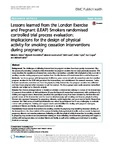Lessons learned from the London Exercise and Pregnant (LEAP) Smokers randomised controlled trial process evaluation: implications for the design of physical activity for smoking cessation interventions during pregnancy
| dc.contributor.author | Giatras, N | |
| dc.contributor.author | Wanninkhof, E | |
| dc.contributor.author | Leontowitsch, M | |
| dc.contributor.author | Lewis, B | |
| dc.contributor.author | Taylor, Adrian | |
| dc.contributor.author | Cooper, S | |
| dc.contributor.author | Ussher, M | |
| dc.date.accessioned | 2017-05-09T13:06:31Z | |
| dc.date.available | 2017-05-09T13:06:31Z | |
| dc.date.issued | 2017-12 | |
| dc.identifier.issn | 1471-2458 | |
| dc.identifier.issn | 1471-2458 | |
| dc.identifier.other | 85 | |
| dc.identifier.uri | http://hdl.handle.net/10026.1/9204 | |
| dc.description.abstract |
BACKGROUND: The challenges of delivering interventions for pregnant smokers have been poorly documented. Also, the process of promoting a physical activity intervention for pregnant smokers has not been previously recorded. This study describes the experiences of researchers conducting a randomised controlled trial of physical activity as an aid to smoking cessation during pregnancy and explores how the effectiveness of future interventions could be improved. METHODS: Two focus groups, with independent facilitators, were conducted with six researchers who had enrolled pregnant smokers in the LEAP trial, provided the interventions, and administered the research measures. Topics included recruitment, retention and how the physical activity intervention for pregnant smokers was delivered and how it was adapted when necessary to suit the women. The focus groups were audio-recorded, transcribed verbatim and subjected to thematic analysis. RESULTS: Five themes emerged related to barriers or enablers to intervention delivery: (1) nature of the intervention; (2) personal characteristics of trial participants; (3) practical issues; (4) researchers' engagement with participants; (5) training and support needs. Researchers perceived that participants may have been deterred by the intensive and generic nature of the intervention and the need to simultaneously quit smoking and increase physical activity. Women also appeared hampered by pregnancy ailments, social deprivation, and poor mental health. Researchers observed that their status as health professionals was valued by participants but it was challenging to maintain contact with participants. Training and support needs were identified for dealing with pregnant teenagers, participants' friends and family, and post-natal return to smoking. CONCLUSIONS: Future exercise interventions for smoking cessation in pregnancy may benefit by increased tailoring of the intervention to the characteristics of the women, including their psychological profile, socio-economic background, pregnancy ailments and exercise preferences. Delivering an effective physical activity intervention for smoking cessation in pregnancy may require more comprehensive training for those delivering the intervention, particularly with regard to dealing with teenage smokers and smokers' friends and family, as well as for avoiding post-natal return to smoking. TRIAL REGISTRATION: ISRCTN48600346 , date of registration: 21/07/2008. | |
| dc.format.extent | 85- | |
| dc.format.medium | Electronic | |
| dc.language | en | |
| dc.language.iso | en | |
| dc.publisher | Springer Science and Business Media LLC | |
| dc.subject | Process evaluation | |
| dc.subject | Researchers' perspective | |
| dc.subject | Smoking cessation | |
| dc.subject | Physical activity intervention | |
| dc.subject | Exercise | |
| dc.subject | Pregnant smokers | |
| dc.subject | Qualitative | |
| dc.title | Lessons learned from the London Exercise and Pregnant (LEAP) Smokers randomised controlled trial process evaluation: implications for the design of physical activity for smoking cessation interventions during pregnancy | |
| dc.type | journal-article | |
| dc.type | Journal Article | |
| dc.type | Randomized Controlled Trial | |
| plymouth.author-url | https://www.webofscience.com/api/gateway?GWVersion=2&SrcApp=PARTNER_APP&SrcAuth=LinksAMR&KeyUT=WOS:000392879100004&DestLinkType=FullRecord&DestApp=ALL_WOS&UsrCustomerID=11bb513d99f797142bcfeffcc58ea008 | |
| plymouth.issue | 1 | |
| plymouth.volume | 17 | |
| plymouth.publication-status | Published online | |
| plymouth.journal | BMC Public Health | |
| dc.identifier.doi | 10.1186/s12889-017-4013-5 | |
| plymouth.organisational-group | /Plymouth | |
| plymouth.organisational-group | /Plymouth/Faculty of Health | |
| plymouth.organisational-group | /Plymouth/Faculty of Health/Peninsula Medical School | |
| plymouth.organisational-group | /Plymouth/REF 2021 Researchers by UoA | |
| plymouth.organisational-group | /Plymouth/REF 2021 Researchers by UoA/UoA03 Allied Health Professions, Dentistry, Nursing and Pharmacy | |
| plymouth.organisational-group | /Plymouth/Research Groups | |
| plymouth.organisational-group | /Plymouth/Research Groups/FoH - Community and Primary Care | |
| plymouth.organisational-group | /Plymouth/Research Groups/Institute of Health and Community | |
| plymouth.organisational-group | /Plymouth/Research Groups/Institute of Translational and Stratified Medicine (ITSMED) | |
| plymouth.organisational-group | /Plymouth/Research Groups/Institute of Translational and Stratified Medicine (ITSMED)/CCT&PS | |
| plymouth.organisational-group | /Plymouth/Research Groups/Plymouth Institute of Health and Care Research (PIHR) | |
| plymouth.organisational-group | /Plymouth/Users by role | |
| plymouth.organisational-group | /Plymouth/Users by role/Academics | |
| plymouth.organisational-group | /Plymouth/Users by role/Researchers in ResearchFish submission | |
| dc.publisher.place | England | |
| dcterms.dateAccepted | 2017-01-02 | |
| dc.identifier.eissn | 1471-2458 | |
| dc.rights.embargoperiod | Not known | |
| rioxxterms.versionofrecord | 10.1186/s12889-017-4013-5 | |
| rioxxterms.licenseref.uri | http://www.rioxx.net/licenses/all-rights-reserved | |
| rioxxterms.licenseref.startdate | 2017-12 | |
| rioxxterms.type | Journal Article/Review | |
| plymouth.oa-location | https://bmcpublichealth.biomedcentral.com/articles/10.1186/s12889-017-4013-5 |


